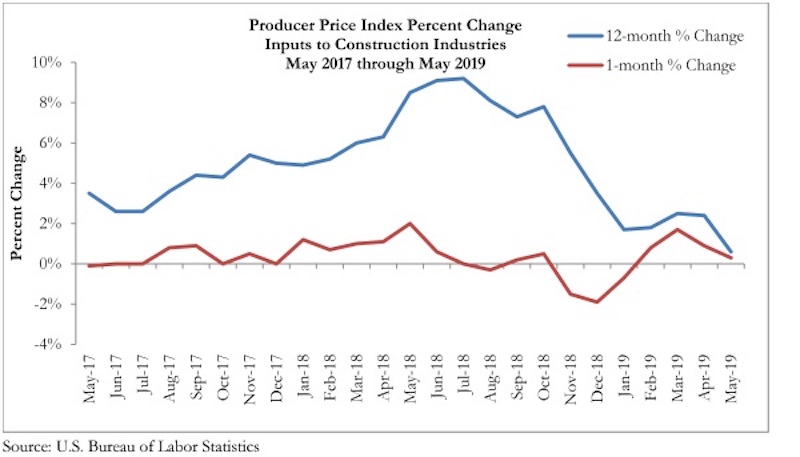Construction input prices rose slightly by 0.3% in May on a monthly basis and are up 0.6% over the last 12 months, according to an Associated Builders and Contractors analysis of U.S. Bureau of Labor Statistics data released today. Nonresidential input prices were also up 0.3% compared to the previous month and are 1.1% higher than they were a year ago.
Among the 11 subcategories, six saw prices fall last month, with the largest decreases in natural gas (-15.2%), unprocessed energy materials (-8.2%) and crude petroleum (-6.2%). Of the remaining five subcategories, only two experienced price increases greater than 1%: nonferrous wire and cable (+1.2%) and prepared asphalt, tar roofing and siding products (+1.1%), which also had the largest year-over-year price increase at 6.3%.
“Based on a variety of factors, materials prices should be escalating in the United States, yet nonresidential construction materials prices remain relatively stable,” said ABC Chief Economist Anirban Basu. “First, demand for materials remains high in the context of ongoing growth in nonresidential construction spending. This is especially true for a number of construction material intensive segments like highway and street. Indeed, prepared asphalt is the only category of construction materials that this report monitors that experienced a price increase exceeding 6% over the past year.
“Second, there is the issue of tariffs, including those that have impacted steel and aluminum prices in recent months,” said Basu. “Despite those surcharges on imported goods, no related categories are associated with significant inflationary pressure, though the price of fabricated steel products is up by a somewhat-above-average 2.8% over the past year. Third, there have been active attempts by certain groups of suppliers, including OPEC members, to truncate supply in an effort to raise prices. In large measure, those efforts have failed, with a host of commodity prices, including oil prices, declining recently.
“There are many factors that have helped to limit materials price increases, including a weakening global economy and the emergence of goods-producing nations like Vietnam and Indonesia,” said Basu. "A strong U.S. dollar has also helped to limit the commodity price increases encountered by America’s construction firms.
“For contractors, this comes as good news,” said Basu. “While U.S. construction firms will continue to wrestle with rising compensation costs, materials prices are likely to remain well behaved over the near term. There is little evidence that the global economy is reaccelerating. Moreover, the Trump administration recently removed tariffs on steel and aluminum with respect to Canada and Mexico. Finally, while public construction spending growth has been robust of late, there is some evidence that spending growth has become less intense in a number of private construction segments, which would have the effect of limiting demand for certain materials, all things being equal.”
Related Stories
Market Data | Oct 31, 2016
Nonresidential fixed investment expands again during solid third quarter
The acceleration in real GDP growth was driven by a combination of factors, including an upturn in exports, a smaller decrease in state and local government spending and an upturn in federal government spending, says ABC Chief Economist Anirban Basu.
Market Data | Oct 28, 2016
U.S. construction solid and stable in Q3 of 2016; Presidential election seen as influence on industry for 2017
Rider Levett Bucknall’s Third Quarter 2016 USA Construction Cost Report puts the complete spectrum of construction sectors and markets in perspective as it assesses the current state of the industry.
Industry Research | Oct 25, 2016
New HOK/CoreNet Global report explores impact of coworking on corporate real rstate
“Although coworking space makes up less than one percent of the world’s office space, it represents an important workforce trend and highlights the strong desire of today’s employees to have workplace choices, community and flexibility,” says Kay Sargent, Director of WorkPlace at HOK.
Market Data | Oct 24, 2016
New construction starts in 2017 to increase 5% to $713 billion
Dodge Outlook Report predicts moderate growth for most project types – single family housing, commercial and institutional building, and public works, while multifamily housing levels off and electric utilities/gas plants decline.
High-rise Construction | Oct 21, 2016
The world’s 100 tallest buildings: Which architects have designed the most?
Two firms stand well above the others when it comes to the number of tall buildings they have designed.
Market Data | Oct 19, 2016
Architecture Billings Index slips consecutive months for first time since 2012
“This recent backslide should act as a warning signal,” said AIA Chief Economist, Kermit Baker.
Market Data | Oct 11, 2016
Building design revenue topped $28 billion in 2015
Growing profitability at architecture firms has led to reinvestment and expansion
Market Data | Oct 4, 2016
Nonresidential spending slips in August
Public sector spending is declining faster than the private sector.
Industry Research | Oct 3, 2016
Structure Tone survey shows cost is still a major barrier to building green
Climate change, resilience and wellness are also growing concerns.
Industry Research | Sep 27, 2016
Sterling Risk Sentiment Index indicates risk exposure perception remains stable in construction industry
Nearly half (45%) of those polled say election year uncertainty has a negative effect on risk perception in the construction market.



















